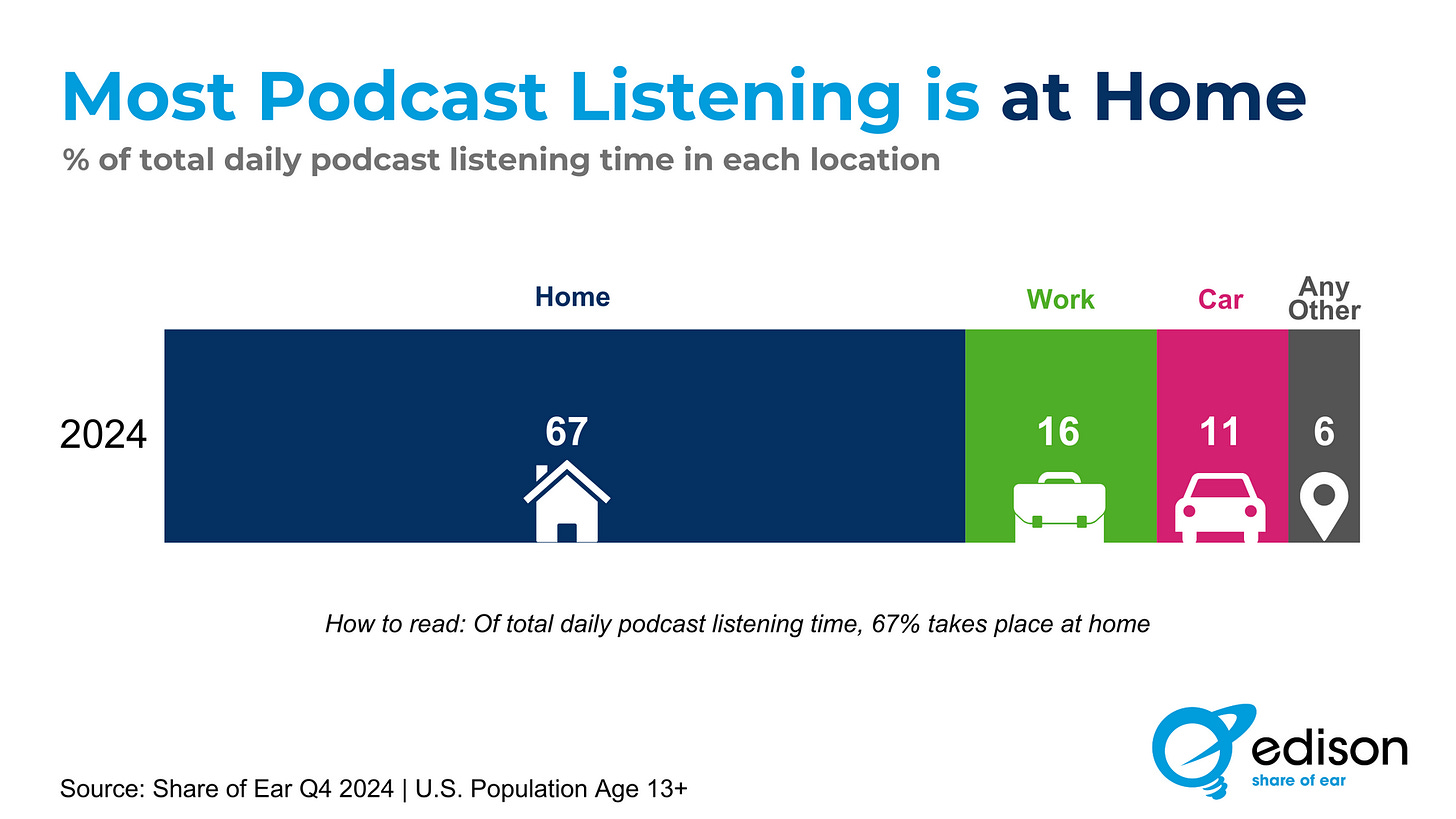Podcasts Find Their Home Sweet Home: Why Your Living Room is Winning the Listening Battle
New Edison Research reveals 67% of podcast listening happens at home, not in cars. Learn how podcasters can optimize content for where listeners really are.
Today's post is (once again) powered by Podwires Marketplace. The Podwires Marketplace is an easy platform to find top podcast service providers and podcast producers. We've handpicked them and we're ready to bring your big or small project ideas to life. Together we can easily achieve your business goals!
Discover podcast experts who understand your market and can effortlessly help you grow your business.
Learn more right on the home page → https://marketplace.podwires.com
Edison Research's latest Share of Ear study reveals that 67% of podcast consumption occurs at home, not during commutes, as commonly believed. This contradicts the conventional wisdom about podcast listening habits and offers content creators an opportunity to tailor their production approach to match where their audience is engaging with their content.
The study revealed that 16% of listening time is spent in work environments, in contrast to only 11% in cars. This dominance is due to the presence of multiple listening devices like smart speakers and internet-connected TVs, the ability to view video podcasts on larger screens, and the ease of multitasking while listening. Additionally, the study underscores that short car trips may hinder full podcast engagement, elucidating the lower percentage of in-car listening. The wide variety of listening devices at home significantly contributes to making it the main location for podcast consumption.
The Key Points:
67% of total daily podcast consumption happens at home, challenging the common perception that cars are the primary listening location
At-work environments account for 16% of podcast listening time
In-car listening captures only 11% of daily podcast consumption
Multiple device options at home (smart speakers, TVs, computers) contribute to home's dominance
At-home listening supports multitasking behaviors observed in qualitative research
Why It Matters
The discovery that the majority of podcast listening occurs at home rather than during commutes fundamentally alters the approach podcasters should take towards content creation. This matters because understanding where your audience actually consumes your content helps you design better experiences for them—from optimal episode lengths to sound design that works in home environments. This allows podcasters to develop more captivating content that seamlessly integrates with home activities, potentially resulting in higher-quality shows. Rather than focusing exclusively on car-friendly formats, podcast producers now have data-backed reasons to explore formats that complement at-home activities and take advantage of the wider range of devices available there.
The Big Picture
The dominance of at-home podcast listening transforms how podcasters should approach content creation, distribution, and monetization. For podcast producers, this revelation means reconsidering episode length, format choices, and even technical production elements to better serve the at-home listener who may be multitasking or has access to larger screens. This change opens up opportunities to create more engaging content that utilizes the home environment, work closely with smart speaker platforms for improved integration, and produce additional visual content for viewers on larger screens. By aligning production strategies with how listeners actually consume podcasts, creators can enhance engagement and potentially increase retention and monetization opportunities.
How Podcasters Can Adapt to Home Listening Dominance
To capitalize on this insight, podcasters should create content that aligns with typical at-home activities. Craft episodes with organic pauses to cater to multitasking listeners and enhance their overall experience. Optimize your audio for home listening environments, which may have different ambient noise considerations than cars. Create companion visual content for episodes, knowing that many listeners have access to screens. Enhance your podcast's accessibility in the home environment by honing your smart speaker capabilities. Take into account the timing of your releases to coincide with peak at-home hours when people are most open to consuming new content. By aligning your production strategy with these at-home listening patterns, you can create more engaging experiences that reflect your audience's true preferences, instead of following conventional beliefs.
If you found this valuable, consider Restacking so more people can see it.
Despite the financial challenges that our industry faces, we have decided to keep our reporting open to the public because we believe that everyone has the right to know the truth about the events that shape their world.
Thanks to the support of our readers, we can continue to provide free reporting. If you can, please choose to support The Podwires




